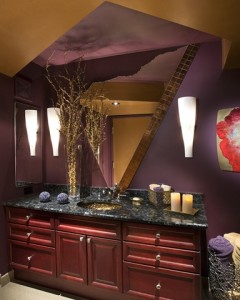Color Power
 When I’m asked as a professional interior designer what I consider the most powerful change people can make in the interior decoration of a room, I tell them hands down it’s interior painting and color. Here’s why:
When I’m asked as a professional interior designer what I consider the most powerful change people can make in the interior decoration of a room, I tell them hands down it’s interior painting and color. Here’s why:
1. Color focuses the eye on what you want people to notice in your room: such as an architectural feature, artwork and the view outdoors. And by using color in blocks, you can create some architecture where there isn’t any.
2. Color can make your room appear larger or more intimate, softer or more striking—without changing another thing in the space. It is NOT true that dark colors make a room look smaller and light colors make the room look larger.
3. Putting your existing furniture against a colorful wall makes it look fresh and new without even re-upholstering. Wood pieces always look better against colorful walls: we’ve known that since colonial times.
4. Color provides an even background for artwork and collectibles that you put on the wall: the color ties everything together.
5. Color can also hide what you don’t want to focus on. If you have a door or window in the wrong place on a wall, simply paint it out! And speaking of windows and doors, if you really want to see that view outside, paint the wall and the areas around windows and doors the same color and watch what happens: all of the focus will be on the outside.
Here are some simple rules to follow when deciding on an interior color scheme:
1. Gather your courage and start with colors that you love, you’ll feel wonderful every time you enter the room. I have found that most people love color, but they’re simply terrified because they always look at it
2. Take a look at the area rugs, artwork, upholstery fabrics and accessories that you already own when choosing a color scheme. The artists that create home furnishings can teach us a lot about color combinations. Pick out at least one dominant color that you like and one neutral. Still not sure? I send clients to their closets to look at the color clothes they enjoy wearing.
3. Don’t let anyone tell you that rich deep-colored walls make rooms smaller or that all ceilings must be white. Think about chocolate walls and the palest sky blue ceiling.
 4. Buy several quarts of various paint colors to test on various walls in the room and look at them at different times of the day. Don’t skimp: paint a patch that is at least 4 feet by 4 feet in size and make sure that you cover the paint that is underneath.
4. Buy several quarts of various paint colors to test on various walls in the room and look at them at different times of the day. Don’t skimp: paint a patch that is at least 4 feet by 4 feet in size and make sure that you cover the paint that is underneath.
5. Most beginners panic and select shades that are too light because they are looking at the sample against a white wall color which makes everything look darker. But remember, that after the room is all painted, that comparison won’t be there.
6. Colors actually not masculine or feminine and colors are not traditional or contemporary. Thinking like that limits the wonderful possibilities that are available to you. It’s what you pair colors with (upholstery, art and accessories) that makes the space gender specific and contemporary or traditional.
Final note: Don’t be afraid! Just remember, it’s only paint!!!!!!
Links: Sherwin Williams, Dunn Edwards, ShapeYourSpaceDesign.com, graberdesigsnltd.com, Marcia Graber